 When I originally booked my flights for this trip, back in July, the most logistically challenging part of the journey was the route across the Pacific Ocean. Flight availability is notoriously difficult for the Pacific legs of round-the-world trips and even that far in advance, I was more or less compelled to commit to 6-days on Easter Island, which seemed to me a long stay for what I assumed would be an exotic curiousity.
When I originally booked my flights for this trip, back in July, the most logistically challenging part of the journey was the route across the Pacific Ocean. Flight availability is notoriously difficult for the Pacific legs of round-the-world trips and even that far in advance, I was more or less compelled to commit to 6-days on Easter Island, which seemed to me a long stay for what I assumed would be an exotic curiousity. In fact, the island was so much more than just a history lesson and an opportunity to take some nice photos. I hadn't imagined that, in addition to the spectacle, atmosphere and
that, in addition to the spectacle, atmosphere and mystery of the statues there would be great surfing, clubbing until 6am and one of the best dives I've done in my life.
mystery of the statues there would be great surfing, clubbing until 6am and one of the best dives I've done in my life.
The island has (left) a great beach and (right) impressive volcanic craters.
 that, in addition to the spectacle, atmosphere and
that, in addition to the spectacle, atmosphere and mystery of the statues there would be great surfing, clubbing until 6am and one of the best dives I've done in my life.
mystery of the statues there would be great surfing, clubbing until 6am and one of the best dives I've done in my life.The island has (left) a great beach and (right) impressive volcanic craters.
My first interest was with the statues so I hired a moped and sped off to see some of the sites. There seems to be a cliche that you leave Easter Island with more unanswered questions than you arrived with. That's understandable, as there doesn't seem to be an undisputed answer for any of the big questions about the Rapa Nui statues...

No-one knows where the people came from (South America or other pacific islands), no-one knows when (though possibly around 1500 years ago) and no-one knows why they built the incredible maoi.
Perhaps the biggest question though is how. And its a question I found myself asking again and again and with increasing disbelief as I toured around the island.
 There are three tiny islands off the south of Easter Island. The top island in the picture is where i went scuba diving. Visibility was incredible - up to 50m - and the dive was an incredible experience. You can also see engravings depicting the 'birdman', a cult which became important to the island's people in the 18th century after the statue building phase had ended.
There are three tiny islands off the south of Easter Island. The top island in the picture is where i went scuba diving. Visibility was incredible - up to 50m - and the dive was an incredible experience. You can also see engravings depicting the 'birdman', a cult which became important to the island's people in the 18th century after the statue building phase had ended.
 There are three tiny islands off the south of Easter Island. The top island in the picture is where i went scuba diving. Visibility was incredible - up to 50m - and the dive was an incredible experience. You can also see engravings depicting the 'birdman', a cult which became important to the island's people in the 18th century after the statue building phase had ended.
There are three tiny islands off the south of Easter Island. The top island in the picture is where i went scuba diving. Visibility was incredible - up to 50m - and the dive was an incredible experience. You can also see engravings depicting the 'birdman', a cult which became important to the island's people in the 18th century after the statue building phase had ended.The statues weighed up to 70 or 80 tonnes and can be up to 10m in length. How a soceity of a few thousand people could create the statues, move them miles across the island and then erect them on ahus (ceremonial platforms) invites speculation but no convincing explanations.
The most impressive site on the island for me was the quarry itself. This one small site was the source of the stone for every moai on the island. And what stands in the quarry today gives an atmospheric and chilling impression of the 'end of days' for the statue makers and their way of life.
 I love this photo, which I got when I went back to the quarry at sunset. Great effort is made on the island to ensure that tourists do not touch the statues, for fear of erosion, but when no-one else is around the horses obviously like to use the statues as scratching posts for their backsides.
I love this photo, which I got when I went back to the quarry at sunset. Great effort is made on the island to ensure that tourists do not touch the statues, for fear of erosion, but when no-one else is around the horses obviously like to use the statues as scratching posts for their backsides.
 I love this photo, which I got when I went back to the quarry at sunset. Great effort is made on the island to ensure that tourists do not touch the statues, for fear of erosion, but when no-one else is around the horses obviously like to use the statues as scratching posts for their backsides.
I love this photo, which I got when I went back to the quarry at sunset. Great effort is made on the island to ensure that tourists do not touch the statues, for fear of erosion, but when no-one else is around the horses obviously like to use the statues as scratching posts for their backsides.There are literally hundreds of statues in the quarry in various stages of being carved, cut out from the rock or erected for transportation to the coastal platforms. We know that production of the statues ceased completely prior to European discovery in the 18th century. But it seems that there was a last frenzied burst of activity before all production mysteriously stopped. The best guess it that it was the amount of effort and resources that the islanders spent on production that resulted in catastrophe. Timber was used to transport the moais from the quarry to their platforms and as more and more trees were cut down some critical point was reached where fishing and farming on the island became unsustainable. The islanders were most likely victims of their own cult.
 One further mystery surrounds the final fate of the maoi. By the 19th century, every maoi on the island had been torn down (those standing today have been re-erected in the 20th century) and its not clear why. One possible answer is that the islanders turned against the gods for whom they had originally erected the statues. Over-population and over-use of the tiny island's natural resources most likely led to ecological and social disaster. There is something haunting about seeing the fallen figures. A lot of local people are convinced that Easter Island contains a message for us all about the fragility of the planet and its resources.
One further mystery surrounds the final fate of the maoi. By the 19th century, every maoi on the island had been torn down (those standing today have been re-erected in the 20th century) and its not clear why. One possible answer is that the islanders turned against the gods for whom they had originally erected the statues. Over-population and over-use of the tiny island's natural resources most likely led to ecological and social disaster. There is something haunting about seeing the fallen figures. A lot of local people are convinced that Easter Island contains a message for us all about the fragility of the planet and its resources.

Even after 6 days I had mixed feelings about leaving Rapa Nui. As the most remote inhabited place on earth, it is never going to make it on to everyone's travel wish-list. But I can't recommend it enough. As far away as it is (and it's a 5-hour flight from Santiago alone), there is a magic about the place that clearly affects every visitor.
 One further mystery surrounds the final fate of the maoi. By the 19th century, every maoi on the island had been torn down (those standing today have been re-erected in the 20th century) and its not clear why. One possible answer is that the islanders turned against the gods for whom they had originally erected the statues. Over-population and over-use of the tiny island's natural resources most likely led to ecological and social disaster. There is something haunting about seeing the fallen figures. A lot of local people are convinced that Easter Island contains a message for us all about the fragility of the planet and its resources.
One further mystery surrounds the final fate of the maoi. By the 19th century, every maoi on the island had been torn down (those standing today have been re-erected in the 20th century) and its not clear why. One possible answer is that the islanders turned against the gods for whom they had originally erected the statues. Over-population and over-use of the tiny island's natural resources most likely led to ecological and social disaster. There is something haunting about seeing the fallen figures. A lot of local people are convinced that Easter Island contains a message for us all about the fragility of the planet and its resources.
Even after 6 days I had mixed feelings about leaving Rapa Nui. As the most remote inhabited place on earth, it is never going to make it on to everyone's travel wish-list. But I can't recommend it enough. As far away as it is (and it's a 5-hour flight from Santiago alone), there is a magic about the place that clearly affects every visitor.



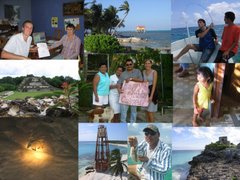
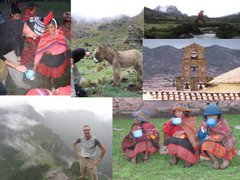
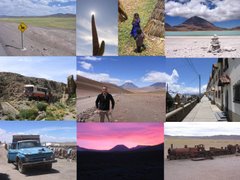
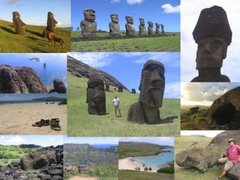
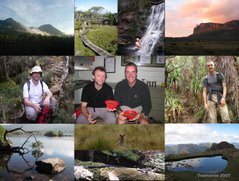
4 comments:
I used to think that everybody knew about the Easter Island statues, and I am keen to go there some day myself. However, as a stopgap measure, I was delighted to discover whilst in Wahington last year that the Smithsonian Natural History museum had two, and they were plain to see in one of those small leaflets you see everywhere advising everyone to come along. Anyhoo, Jill and I arrived at the information desk and asked where we might find these mighty monoliths. Flabbergastingly (© Graeme), the Information desk employees didn't know and thought they might have been archived years ago!!! It was only when we went to leave by a different entrance (some 100m away from the Info desk) that we spotted them. Moral of the story? Go in the back entrance of the Smithsonian Natural History museum.
Hi Graeme - thanks for the comment. I know you have had to go in the back entrances of courthouses and nightclubs for some time now. Disturbing to note that you have had to add museums to that list.
BTW Interesting fact (possibly!) - there are only 6 Easter Island statues outside of Easter Island itself. A bit flashy to have nabbed two of those... and then forget you have them.
Wow... those pics are amazing. You really should look into selling them! I can't help but wish that i went to Easter Island after seeing them.
Addy :)
Hi again Addy!
Yeah, someone else has mentioned selling photos. I'm ashamed to say I don't know much about how to go about that. Any ideas? Di took away a CD of my best photos and will flaunt them at the Telegraph as/when she gets the chance.
I also seem to get a lot of interest in the website now, but not sure how to capitalise on that either. But it's the fun that counts!!
Post a Comment